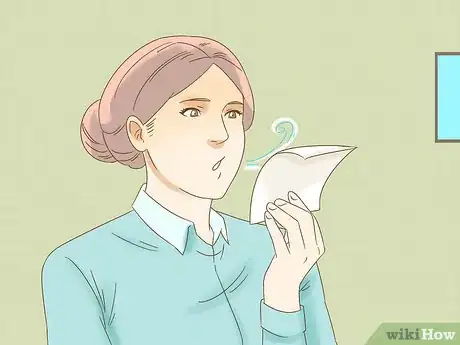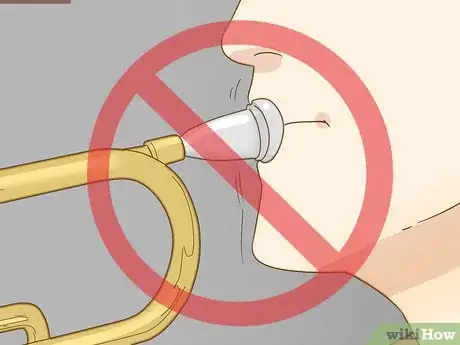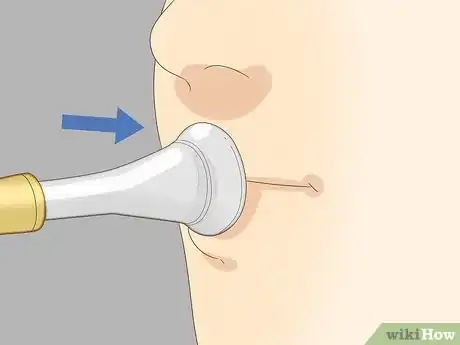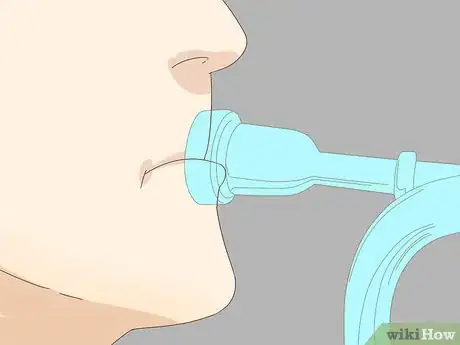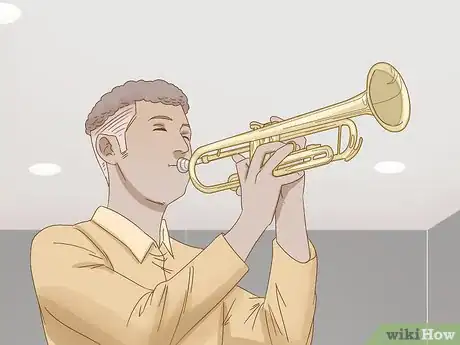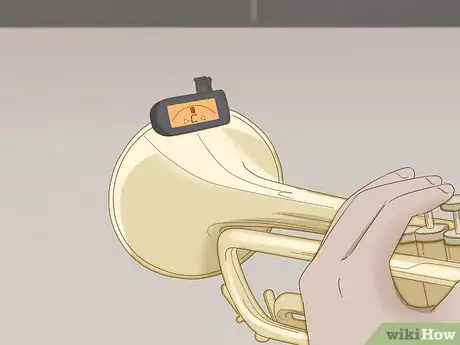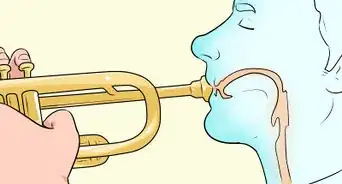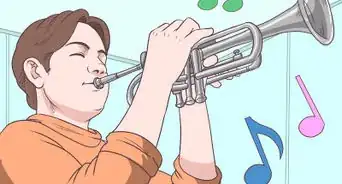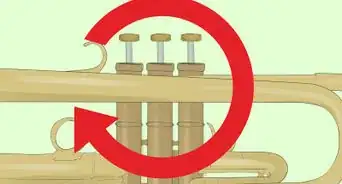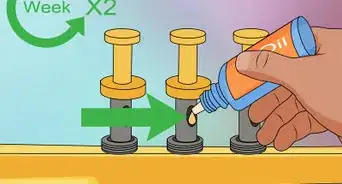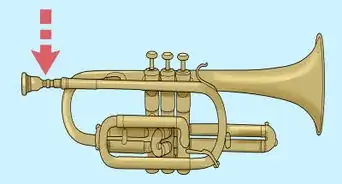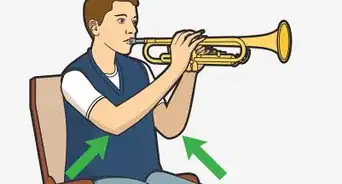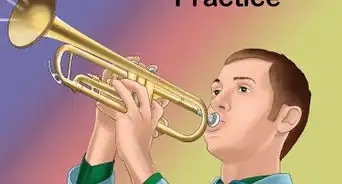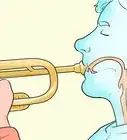This article was co-authored by wikiHow Staff. Our trained team of editors and researchers validate articles for accuracy and comprehensiveness. wikiHow's Content Management Team carefully monitors the work from our editorial staff to ensure that each article is backed by trusted research and meets our high quality standards.
This article has been viewed 70,820 times.
Learn more...
Most brass players (trumpet, trombone, baritone, etc.) run into the dreaded high note wall at one point or another. Many resign themselves to a two octave range, but you can easily master a higher range by utilizing a few simple techniques that work for players of all ages and skill levels. Learn to control airflow, adjust your embouchure, and practice, practice, practice!
Steps
Controlling Airflow
-
1Whistle to learn how to control airflow in the higher registers. Many new trumpet players confuse blowing harder with blowing air faster. Blowing harder puts more air into the instrument and creates a louder sound. Faster air produces higher notes. One way to tell the difference is to whistle. Changing from a lower note to a higher note when whistling, you adjust the shape of the inside of your mouth and position of the tongue to direct the air more quickly. Mimicking this mouth and tongue position while playing trumpet will allow you to hit higher notes.
- Another method of practicing to hit high notes is to make an “ee” sound and feel the shape and position of the tongue in the mouth. This is also a position that will allow you to reach higher notes.[1]
-
2Use your diaphragm to move air. In addition to controlling air in the mouth, you also need to learn how to control your airflow from the lungs. For this, you’ll use the diaphragm, a flat muscle below your lungs. When you inhale, the diaphragm contracts to make room for the lungs. When you exhale, the diaphragm expands pushing the air out. Learning to control the movement of your diaphragm will make controlling the amount and speed of airflow much easier.[2]
- Practice inhaling and exhaling slowly. Count to ten as you breathe in and feel your lungs fully expand and the diaphragm contract. Then, exhale for the same amount of time, paying special attention to the tightening of the diaphragm.
- Without worrying about the quality of sound, inhale slowly and play a long note as you exhale. Inhale again, and this time, change the speed and quantity of air flow and note how it changes the pitch or quality of sound.
Advertisement -
3Support your breathing. The final step in controlling airflow is to make sure you are supporting the air. Players who are not effectively supporting airflow will play notes that waver or have poor tonal quality. You can practice air support by holding a piece of paper in front of your face. Then, you will blow on the paper. With proper air support, the paper should move outward at a consistent angle. Without air support, the paper, like the trumpet’s tone, will waver.
Adjusting Embouchure
-
1Understand the role your lips play. Embouchure, the position of the mouth while playing, is a key component to hitting and holding high notes. Your lips vibrate on the surface as you push air past them. This creates necessary resistance to direct the stream through the trumpet and make sound. Most players position their lower lip just under the upper lip, creating a seal. This seal prevents the lips from parting when players “buzz” their lips to play a note. This is especially important for high notes, where the fast air increases the risk that the seal will break and the note will crack or drop.[3]
-
2Stop your body from stiffening. Many trumpet players squeeze their lips more tightly together and tense their stomach muscles to hit high notes. This method may work once or twice, but the notes you produce will likely be of poor tonal quality, either flat or sharp. You need to learn to relax your mouth and body while playing high notes in order to achieve a clear high note tone.
-
3Avoid pressing your lips too hard against the mouthpiece. This can cause damage to your lips that may prevent you from practicing for a while, or it may even lead to irreversible damage. Like tensing up when you play, pressing your lips into the mouthpiece can allow you to play a higher note once or twice, but you will not be able to play notes consistently using this method.
-
4Relax the upper lip. It’s especially important to stop yourself from stiffening the upper lip. This is the most often tensed part of the embouchure, and when you do this, you actually make it more difficult to reach high notes. The fast air moving between your lips causes vibration, but when you tense the mouth, the air is unable to move the lip and achieve the pitch you’re aiming for.[4]
-
5Learn the basic embouchure. Starting out, most trumpeters are taught the Farkas embouchure. You may remember early trumpet lessons where you were instructed to tighten the corners of your mouth, pinch lips together, and blow air through creating a buzzing sound. This is the Farkas method, and it is popular because it works. However, for higher notes, it may actually put too much strain on the lip muscles because the fast moving air wants to force the lips apart. Instead, you may want to consider adjusting to the Stevens or Super Chops embouchures.
-
6Practice the Stevens embouchure. This method requires you to roll in either the upper or lower lip. This creates a tighter seal because one of your lips will slightly overlap the other, making it easier to keep lips together while increasing air speed to hit high notes.
-
7Try the Super Chops embouchure. This method also overlaps the lips similarly to the Stevens embouchure. Instead of rolling the lip to accomplish this, the bottom lip remains flat and slides over the top teeth and under the top lip to create a seal.
Practicing the High Range
-
1Practice high notes every day. You need to spend at least an hour each day playing the trumpet, but you shouldn’t dedicate more than ten percent of your playing time to high notes. That means if you practice for an hour a day, only six minutes of your practice should be devoted to improving your range. That’s because being able to effortlessly play notes in the mid range actually improves your high range. It’s twice as hard to play a C above the scale as it is to play the middle C tuning note. The easier it is for you to hit middle C, the easier it will be to play high C.
-
2Play lip slurs. Practicing lip slurs helps to develop your lip strength, and it is the key to learning and being able to maintain high notes. You can find lip slur exercises online, or you can do something as simple as slurring up and down a chromatic scale. In fact, slurring the chromatic scale is a great way to train your ear to hear sharpness and flatness on higher notes. Because you are playing a series of notes each just half a step apart, you should hear if one of the notes isn’t in tune.
-
3Adjust to stay on pitch. Playing high notes is a challenge, but playing high notes in tune can be even more difficult. When you’re working on your range, keep an electric tuner on your stand, and make adjustments to lip, tongue, and mouth position as well as airflow, if you notice your pitch becomes flat or sharp on high notes.
- A good way to start is to slur up and down a chromatic scale. Because you are not tonguing to change the note, you really have to concentrate on adjusting the mouth and airflow to hit the notes.
- You may also want to try playing a melody you’re familiar with up one or more octaves. Because your ear is already trained to recognize the melody, you are more likely to hear when the pitch goes sharp or flat.
- You can also try out some trumpet standards that have high notes such as "Boogie Woogie Bugle Boy" or Chuck Mangione's classic "Feels so Good."
-
4Ask fellow musicians for help. When you're learning a new skill or sharpening skills you possess, it’s important to find a support system of other trumpet players. It’s sometimes difficult to assess your own skill level, especially as you’re learning, so ask a friend who plays trumpet to sit in and listen to you play. If there’s a band mate who seems to really excel at playing high notes, approach them and ask if they would consider working with you on your technique.
- You may also want to consider hiring a professional trumpet instructor to take lessons, if you don’t already do so. These professionals offer essential advice and practice tips to help you improve every aspect of your trumpet playing ability including your range. Additionally, lessons help you stay accountable to investing time to practice every day.


